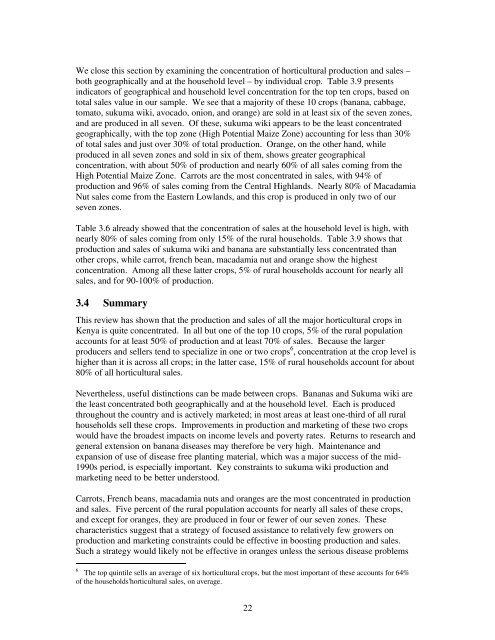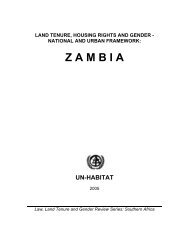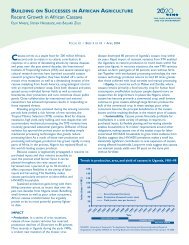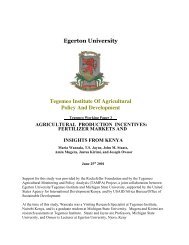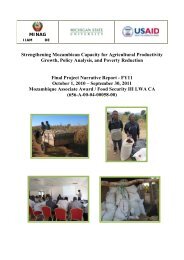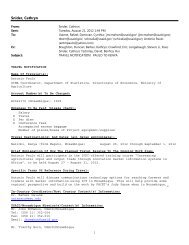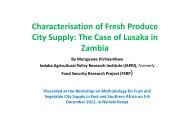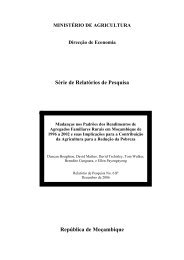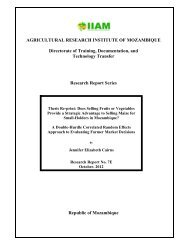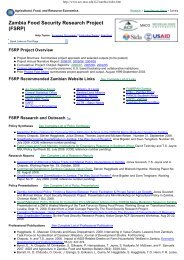Improving Kenya's Domestic Horticultural Production and Marketing
Improving Kenya's Domestic Horticultural Production and Marketing
Improving Kenya's Domestic Horticultural Production and Marketing
You also want an ePaper? Increase the reach of your titles
YUMPU automatically turns print PDFs into web optimized ePapers that Google loves.
We close this section by examining the concentration of horticultural production <strong>and</strong> sales –<br />
both geographically <strong>and</strong> at the household level – by individual crop. Table 3.9 presents<br />
indicators of geographical <strong>and</strong> household level concentration for the top ten crops, based on<br />
total sales value in our sample. We see that a majority of these 10 crops (banana, cabbage,<br />
tomato, sukuma wiki, avocado, onion, <strong>and</strong> orange) are sold in at least six of the seven zones,<br />
<strong>and</strong> are produced in all seven. Of these, sukuma wiki appears to be the least concentrated<br />
geographically, with the top zone (High Potential Maize Zone) accounting for less than 30%<br />
of total sales <strong>and</strong> just over 30% of total production. Orange, on the other h<strong>and</strong>, while<br />
produced in all seven zones <strong>and</strong> sold in six of them, shows greater geographical<br />
concentration, with about 50% of production <strong>and</strong> nearly 60% of all sales coming from the<br />
High Potential Maize Zone. Carrots are the most concentrated in sales, with 94% of<br />
production <strong>and</strong> 96% of sales coming from the Central Highl<strong>and</strong>s. Nearly 80% of Macadamia<br />
Nut sales come from the Eastern Lowl<strong>and</strong>s, <strong>and</strong> this crop is produced in only two of our<br />
seven zones.<br />
Table 3.6 already showed that the concentration of sales at the household level is high, with<br />
nearly 80% of sales coming from only 15% of the rural households. Table 3.9 shows that<br />
production <strong>and</strong> sales of sukuma wiki <strong>and</strong> banana are substantially less concentrated than<br />
other crops, while carrot, french bean, macadamia nut <strong>and</strong> orange show the highest<br />
concentration. Among all these latter crops, 5% of rural households account for nearly all<br />
sales, <strong>and</strong> for 90-100% of production.<br />
3.4 Summary<br />
This review has shown that the production <strong>and</strong> sales of all the major horticultural crops in<br />
Kenya is quite concentrated. In all but one of the top 10 crops, 5% of the rural population<br />
accounts for at least 50% of production <strong>and</strong> at least 70% of sales. Because the larger<br />
producers <strong>and</strong> sellers tend to specialize in one or two crops 6 , concentration at the crop level is<br />
higher than it is across all crops; in the latter case, 15% of rural households account for about<br />
80% of all horticultural sales.<br />
Nevertheless, useful distinctions can be made between crops. Bananas <strong>and</strong> Sukuma wiki are<br />
the least concentrated both geographically <strong>and</strong> at the household level. Each is produced<br />
throughout the country <strong>and</strong> is actively marketed; in most areas at least one-third of all rural<br />
households sell these crops. Improvements in production <strong>and</strong> marketing of these two crops<br />
would have the broadest impacts on income levels <strong>and</strong> poverty rates. Returns to research <strong>and</strong><br />
general extension on banana diseases may therefore be very high. Maintenance <strong>and</strong><br />
expansion of use of disease free planting material, which was a major success of the mid-<br />
1990s period, is especially important. Key constraints to sukuma wiki production <strong>and</strong><br />
marketing need to be better understood.<br />
Carrots, French beans, macadamia nuts <strong>and</strong> oranges are the most concentrated in production<br />
<strong>and</strong> sales. Five percent of the rural population accounts for nearly all sales of these crops,<br />
<strong>and</strong> except for oranges, they are produced in four or fewer of our seven zones. These<br />
characteristics suggest that a strategy of focused assistance to relatively few growers on<br />
production <strong>and</strong> marketing constraints could be effective in boosting production <strong>and</strong> sales.<br />
Such a strategy would likely not be effective in oranges unless the serious disease problems<br />
6 The top quintile sells an average of six horticultural crops, but the most important of these accounts for 64%<br />
of the households’horticultural sales, on average.<br />
22


